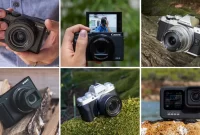Are you confused about whether to invest in a DSLR or a mirrorless camera? In this article, we will delve into the key differences and help you decide which one is the perfect fit for your photography needs.
Differences in Image Quality
When comparing DSLR and mirrorless cameras, one important factor to consider is the difference in image quality between the two.
DSLR Cameras
DSLR cameras are known for their exceptional image quality. They often feature larger image sensors, allowing for greater detail and better low-light performance. The optical viewfinder in DSLRs provides a clear and accurate representation of the scene.
Additionally, DSLRs have a wider range of available lenses, including some high-quality options that can further enhance the image quality.
Mirrorless Cameras
Mirrorless cameras, on the other hand, have been catching up with DSLRs in terms of image quality. Although their image sensors are generally smaller, advancements in technology have greatly improved their performance.
The absence of a mirror allows for a more compact design, making mirrorless cameras easier to carry and handle. They often come equipped with electronic viewfinders that simulate the image before capturing it.
Choosing the Right Camera
When deciding between DSLR and mirrorless cameras, it ultimately comes down to personal preferences and specific needs. If image quality is your top priority and you’re willing to invest in high-quality lenses, a DSLR might be the better choice.
However, if portability and versatility are key factors for you, and you’re willing to sacrifice a bit of image quality, a mirrorless camera can be a great option.
Size and Portability
When comparing DSLR and mirrorless cameras, one of the key factors to consider is their size and portability. DSLR cameras, typically equipped with a mirror and a prism, tend to be larger and heavier compared to mirrorless cameras. This larger size can make them less convenient to carry around, especially on long trips or when you need to remain mobile.
On the other hand, mirrorless cameras are designed to be more compact and lightweight. By eliminating the need for a mirror and prism, manufacturers are able to create smaller camera bodies. This makes mirrorless cameras highly portable, allowing photographers to bring them along for various shooting situations without feeling weighed down.
The compact size of mirrorless cameras also makes them suitable for street photography or situations where discretion is preferred. Their smaller form factor allows photographers to blend into the environment more easily, capturing candid moments without drawing too much attention to themselves.
However, it’s important to note that the size advantage of mirrorless cameras doesn’t only apply to the camera body itself. Lens size is another aspect to consider. Mirrorless cameras often feature smaller lenses due to their shorter flange focal distance. This further contributes to a more versatile and portable photography setup.
Availability of Lenses
In the world of photography, one crucial factor to consider when choosing between DSLR and mirrorless cameras is the availability of lenses. Both camera types offer a wide range of lens options, but there are some differences to be aware of.
DSLR cameras have been around for a longer time and have a larger market share. As a result, there is a wider selection of lenses available for DSLRs. This includes a variety of lenses from the camera manufacturer itself as well as third-party lens manufacturers.
On the other hand, mirrorless cameras are gaining popularity rapidly, and lens options are constantly expanding. While mirrorless lenses may have been limited in the past, major camera manufacturers are now investing heavily in their mirrorless lens lineup. This means that there are now more lenses available for mirrorless cameras than ever before.
It’s important to note that some lenses are specific to either DSLR or mirrorless cameras. DSLR lenses generally cannot be used on mirrorless cameras without an adapter, and vice versa. However, adapters are available on the market that can allow cross-compatibility to some extent.
Overall, the availability of lenses for both DSLR and mirrorless cameras is improving. Whether you choose a DSLR or mirrorless camera, you will have a wide array of lenses to choose from to suit your photography needs.
Conclusion
Ultimately, choosing between a DSLR and a mirrorless camera depends on your specific needs and preferences. If you value versatility, advanced features, and a wide range of lens options, a DSLR may be the better choice. On the other hand, if you prioritize portability, convenience, and advanced autofocus systems, a mirrorless camera would be a more suitable option. Consider your photography style, budget, and desired features before making a decision.




